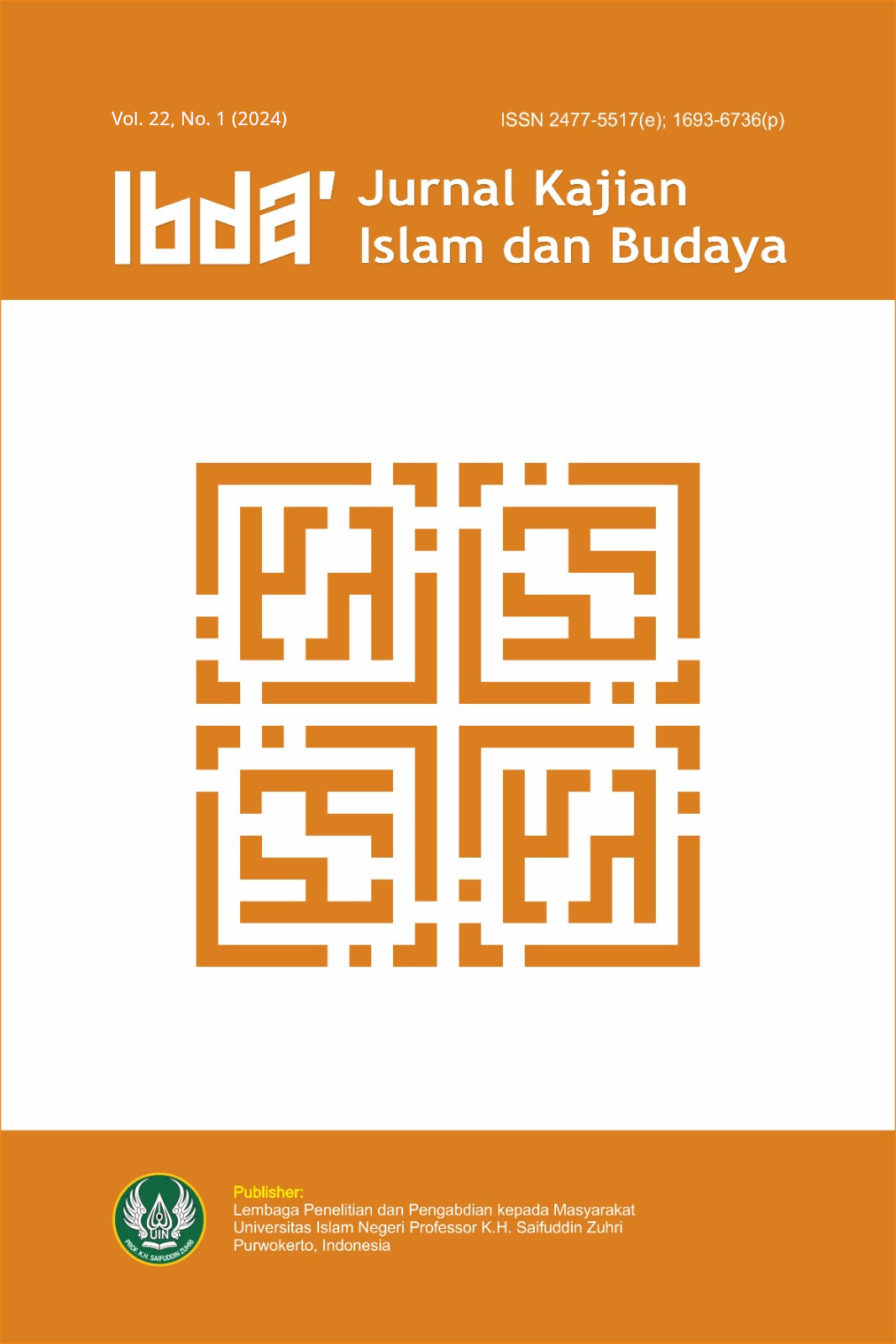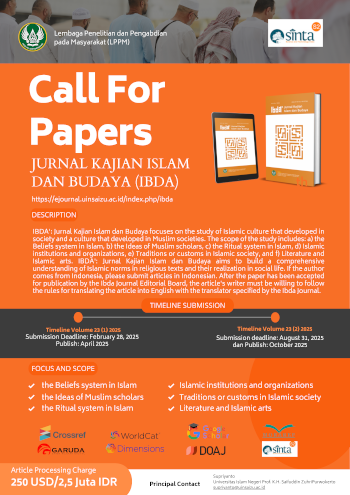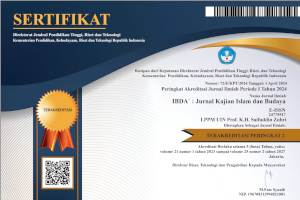A Signs and Meanings of Pamali Utterances in The Religiosity of Kampung Naga Indigenous Communities: A Semiotic Theory Perspective
A Semiotic Theory Perspective
DOI:
https://doi.org/10.24090/ibda.v22i1.10722Keywords:
Pamali, signs and meaning, Islamic religiosity, semiotic theoryAbstract
This research is motivated by differences in people's beliefs regarding the Pamali (taboo) tradition, which is considered by some groups to represent wisdom, but by as a type of superstition that must be avoided. This results in the Pamali tradition beginning to be marginalised from modern life. However, in the Kampung Naga, one of the villages in Indonesia , the tradition is still maintained in the practice of religion and modernisation. The paper aims to analyse Pamali utterances based on the perspective of semiotic theory and their relationship with the religiosity of the Kampung Naga indigenous community. The qualitative research uses an phenomenological design that applies linguistic theory as an analytical tool. It was found that according to the theory of meaning, Pamali utterances are based on the relevance of the relationship between sign, referent, and interpretant. Pamali is interpreted as taboo by society, and therefore people do not violate it. The content of the message in Pamali utterances is in harmony with the content of the Islamic message, so the reflection is a crystallisation of the religious teachings adhered to by the village people.Downloads
References
Al-Jamal, S. (1996). Hasyiyah Al-Jamal (juz III). Dar al-Fikr.
Amanda, S. N., & Pindi, S. (2014). Perancangan Buku Ilustrasi mengenai Pamali Sunda Seputar Kehamilan [Design of an Illustrated Book about Sundanese Pamali Regarding Pregnancy]. Jurnal Tingkat Sarjana Bidang Senirupa Dan Desain.
Anam, S. (2020). Pamali dalam Pernikahan Salep Tarjhe Perspektif Teori Sadd al-Dzariah (Studi di Desa Campor Kecamatan Geger Kabupaten Bangkalan Madura) [Pamali in Marriage Salep Tarjhe Sadd al-Dzariah Theory Perspective (Study in Campor Village, Geger District, Bangkalan. Universitas Islam Negeri Maulana Malik Ibrahim.
Berger, A. A. (2010). Pengantar Semiotika: Tanda-tanda dalam Kebudayaan Kontemporer [Introduction to Semiotics: Signs in Contemporary Culture]. Tiara Wacana.
Darmalaksana, W., Ratnasih, T., & Nur, S. (2022). The Relationship Between Islam and Local Wisdom in the Kampung Naga Tradition: Living Sunnah Research. Living Sunnah Research. Diroyah: Jurnal Studi Ilmu Hadis, 6(2), 115–127.
Djawad, A. A. (2016). Pesan, Tanda, dan Makna dalam Studi Komunikasi [Messages, Signs, and Meaning in Communication Studies]. STILISTIKA: Jurnal Bahasa, Sastra, Dan Pengajarannya, 1(1), 95–101. https://doi.org/10.33654/sti.v1i1.344
Febriyanto, A., Riawanti, S., & Gunawan, B. (2018). Mitos Rambut Gimbal: Identitas Budaya dan Komodifikasi di Dataran Tinggi Dieng [The Myth of Dreadlocks: Cultural Identity and Commodification in the Dieng Plateau]. Umbara, 2(1). https://doi.org/10.24198/umbara.v2i1.15670
Halliday, M. A. K. (1979). Languange as Social Semiotics: The Social Interpretation of Languange and Meaning. Edward Arnold.
Kaelan, K. (2009). Filsafat Bahasa, Semiotika, dan Hermeneutika [Philosophy of Language, Semiotics, and Hermeneutics]. Paradigma.
Karim, H. A. (2018). Evaluasi Penentuan Waktu Tanam Padi (Oriza Sativa L.) Berdasarkan Analisa Curah Hujan Dan Ketersediaan Air Pada Wilayah Bedungan Sekka-Sekka Kabupaten Polewali Mandar [Evaluation of Determining the Time to Plant Rice (Oriza Sativa L.) Based on Analysis of. Agrovital: Jurnal Ilmu Pertanian Universitas Al Asyariah, 3(2).
Levinson, C. S. (1983). Pragmatics. Cambridge University Press.
Moleong, L. J. (2006). Metodologi Penelitian Kualitatif [Qualitative Research Methodology]. Remaja Rosdakarya.
Njatrijani, R. (2018). Kearifan Lokal Dalam Perspektif Budaya Kota Semarang [Local Wisdom in the Cultural Perspective of Semarang City]. Gema Keadilan, 5(1), 16–31. https://doi.org/10.14710/gk.2018.3580
Noth, W. (1995). Handbook of Semiotics. indiana University Press.
Piliang, Y. A. (2004). Semiotika Teks : Sebuah Pendekatan Analisis Teks [Text Semiotics: An Approach to Text Analysis]. Mediator: Jurnal Komunikasi, 5(2), 189–198. https://ejournal.unisba.ac.id/index.php/mediator/article/view/1156/715
Putikadyanto, A. P. A., & Sefrianah, N. A. (2019). Kegiatan Keagamaan dan Pamali Hari Kamis Berjualan di Kabupaten Pasuruan [Thursday Religious Activities and Pamali Selling in Pasuruan Regency]. Religious: Jurnal Studi Agama-Agama Dan Lintas Budaya, 4(1), 1–11. https://journal.uinsgd.ac.id/index.php/Religious/article/view/7605
Qusyaeri, N., & Azhari, F. (2019). Dialektika Budaya Sunda Dan Nilai-Nilai Islam (Studi Atas Nilai-Nilai Dakwah Dalam Budaya Pamali Di Tatar Sunda) [Dialectics of Sundanese Culture and Islamic Values (Study of Da’wah Values in Pamali Culture in Sundanese Land)]. Syntax Idea, 1(4).
Rahmawati, S. T. (2023). Konsep Pendidikan Komunikasi dan Kebudayaan [Concept of Communication and Cultural Education]. Journal on Education, 5(4), 14762–14776. https://doi.org/10.31004/joe.v5i4.2543
Ramli, R. (2018). Bentuk, Makna Dan Fungsi Pamali Pada Perilaku Masyarakat Pesisir Kabupaten Maros: Pendekatan Semiotik [Form, Meaning, and Function of Pamali, in the Behaviour of Coastal Communities in Maros Regency: A Semiotic Approach]. Universitas Hasanuddin Makassar.
Ratmawati, E. (2019). Bentuk Dan Makna Ungkapan Pantang Larang Komunitas Adat Desa Karang Pandan Kecamatan Pakisaji Kabupaten Malang Dalam Sebuah Penafsiran Hermenutika Budaya [The Form and Meaning of the Expression Abstinence Forbidden Traditional Community of Karang Pandan V. Jurnal Ilmiah Bahasa Dan Sastra, 4(2), 116–124. https://doi.org/10.21067/jibs.v4i2.3178
Rusmana, D. (2014). Filsafat Semiotika [Semiotic Philosophy]. Pustaka Setia.
Santoso, P. (1993). Ancangan Semiotika dan Pengkajian Susastra [Semiotic Approaches and Literary Studies]. Angkasa.
Sobur, A. (2013). Semiotika Komunikasi [Communication Semiotics]. Rosdakarya.
Syahrir, E. (2016). Ungkapan Pantang Larang Masyarakat Melayu Belantik [The Taboo Utterance of the Belantik Malay Community]. Madah, 7, 237–250.
Syarbani, S. M. bin M. K., Tamir, M., & Abdullah, S. (2006). Mughni al-Muhtaj ila Ma’rifah Ma’ani Alfadz al-Minhaj. Dar El Hadith.
Syarif, S., Bedong, M. A. R., & Zaenong, A. M. A. (2019). Budaya Pimali dalam Jual Beli pada Masyarakat Pattae [Pimali Culture in Buying and Selling in the Pattae Community]. KURIOSITAS: Media Komunikasi Sosial Dan Keagamaan, 12(2). https://doi.org/10.35905/kur.v12i2.1218
Syarubany, A. H. M., Azzahra, M. P. K., Rahayu, R. S., & Prayoga, S. (2021). Pengaruh Pamali Sebagai Kearifan Lokal Dalam Mewujudkan Nilai Dan Norma Dalam Kehidupan Sosial Generasi Z [The Influence of Pamali as Local Wisdom in Realising Values and Norms in the Social Life of Z Generation]. Jurnal Kewarganegaraan, 5(2), 570–577. https://doi.org/10.31316/jk.v5i2.1945
Widiastuti, H. (2015). Pamali Dalam Kehidupan Masyarakat Kecamatan Cigugur Kabupaten Kuningan (Kajian Semiotik dan Etnopedagogi) [Pamali in Community Life in Cigugur District, Kuningan Regency (Semiotic and Ethnopedagogical Study)]. Lokabasa, 6(1), 71–78. https://doi.org/10.17509/jlb.v6i1.3149
Wolfreis, J. (1999). Literary Theories. New York University Press.
Downloads
Published
How to Cite
Issue
Section
License
Copyright (c) 2024 Nani Widiawati, Mohd Roslan Mohd Nor, Restiani

This work is licensed under a Creative Commons Attribution-ShareAlike 4.0 International License.
Authors who publish with this journal agree to the following terms:
- Authors retain copyright and grant the journal right of first publication with the work simultaneously licensed under a Creative Commons Attribution-ShareAlike License a that allows others to share the work with an acknowledgement of the work's authorship and initial publication in this journal.
- Authors are able to enter into separate, additional contractual arrangements for the non-exclusive distribution of the journal's published version of the work (e.g., post it to an institutional repository or publish it in a book), with an acknowledgment of its initial publication in this journal.
- Authors are permitted and encouraged to post their work online (e.g., in institutional repositories or on their website) before and during the submission process, as it can lead to productive exchanges, as well as earlier and greater citation of published work (See The Effect of Open Access).
















